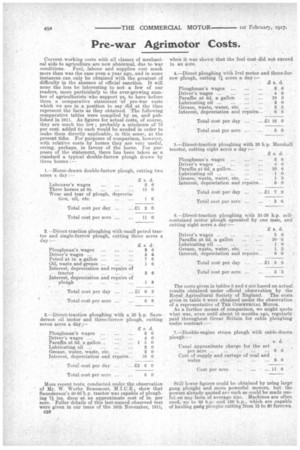Pre-war Agritnotor Costs.
Page 18

If you've noticed an error in this article please click here to report it so we can fix it.
Current working costs with all classes of mechanical aids to agriculture are now abnormal, due to war conditions. Fuel, labour and supplies cost much more than was the case even a year ago, and in some instances can only be obtained with the greatest of difficulty in the absence of official sanction. It will none the less be interesting to not a few of our readers, more particularly to the ever-growing number of agriculturists who support us, to have before them a comparative statement of pre-war costs which we are in a position to say did at the time represent the facts as they obtained. The following comparative tables were compiled by us, and' published in 191i. As figures for actual costs of course, they are much too low ; probably a minimum of 75 per cent, added to each would be needed in order to make them directly applicable, in this sense at the present tithe. For purposes of comparison, however, with relative costs by horses they are very useful, erring, perhaps, in favour of the horse. For purposes of the statement, there has been taken as a standard a typical double-furrow plough drawn by three horses 1.—Horse-drawn double-furrow plough, cutting two acres a day 2. —Direct-traction ploughing with small petrol tractor and single-furrow plough, cutting three acres a day :— 3.--Direct-traction ploughing. with a 30 h.p. Sauna derson oil -motor and three-iurrow plough, cutting seven acres a day:— More recent tests, conducted under the observation of Mr. W. Worby Beaumont, MICE., show that Saunderson's 40-50 h.p. tractor was capable of ploughing 7i ins, deep at an approximate cost of 5s. per acre. Fuller details of this last-named observed test were given in our issue of the 16th November, 1911, 050 when it was shown that the fuel cost did not exceed is. an acre.
4.—Direct ploughing with lire] motor and three-furrow plough, cutting 7,1 acres a day :— 6.—Direct-traction ploughing with 24-30 h.p. selfcontained inetor plough operated by one man, and cutting eight acres a day :— The costs 4iven in tables 3 and 4 are based on actual results obtained under official observation by the Royal Agricultural Society of England. The costs given in table 5 were obtained under the observation of a representative of THE COMMERCIAL MOTOR. As a further means of comparison, we might quote what was, even until about 18 months ago, regularly paid throughout Great Britain for cable ploughing under contract :— Still lower figures could be obtained by using largd gang ploughs and more powerful motors, but the powers already quoted are such as could be made useful on any farm of average size. Machines are often used, up to 80 h.p. and 100 h.p., which are capable of hauling gafig ploughs cutting from 15 to 20 furrows.
























